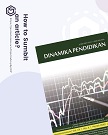The Relationships Between Instagram Social Media Usage, Hedonic Shopping Motives and Financial Literacy on Impulse Buying
(1) Universitas Negeri Semarang, Semarang, Indonesia
(2) Universitas Negeri Semarang, Semarang, Indonesia
(3) Universitas Negeri Semarang, Semarang, Indonesia
Abstract
This research aims to determine the effect of using instagram social media and hedonic shopping motives to impulse buying media and to know whether financial literacy is able to moderate the influence of instagram social media use and hedonic shopping motives to impulse buying. This type of research is quantitative research. The population of this research was students of Accounting Economics Education Study Program of Economics Faculty of Universitas Negeri Semarang (UNNES). The research sample was 110 students of class of 2013 which chosen by using purposive sampling technique. The data was analyzed by using descriptive statistic, simple regression analysis, and interaction test (moderation). The result of the research shows that instagram social media usage and hedonic shopping motives have positive and significant effect to students’ impulse buying. The result of regression analysis shows that financial literacy has negative and significant effect on impulse buying. Thus, financial literacy can moderate the influence of instagram social media usage to impulse buying. However, the other regressive result indicates that financial literacy is not able to moderate the influence of hedonic shopping motives on impulse buying.
Keywords
Full Text:
PDFReferences
Bandyopadhyay, N. (2016). The role of self-esteem , negative affect and normative influence in impulse buying A study from India. Marketing Intelligence & Planning, 34(4), 523–539. http://doi.org/10.1108/MIP-02-2015-0037
Chusniasari, & Prijati. (2015). Pengaruh Shopping Lifestyle, Fashion Involvement dan Hedonic Shopping terhadap Impulse Buying Pelanggan. Jurnal Ilmu Dan Riset Manajemen, 4(12), 1–21.
Darma, L. A., & Japarianto, E. (2014). Analisa Pengaruh Hedonic Shopping Value terhadap Impulse Buying dengan Shopping Lifestyle dan Positive Emotion sebagai Variabel Intervening pada Mall Ciputra World Surabaya. Jurnal Manajemen Pemasaran, 8(2), 80–89. http://doi.org/10.9744/pemasaran.8.2.80-89
Dawson, S., & Kim, M. (2012). External and internal trigger cues of impulse buying online. Direct Marketing: An International Journal, 3(1), 20–34. http://doi.org/10.1108/17505930910945714
Dey, D. K., & Srivastava, A. (2017). Impulse buying intentions of young consumers from a hedonic shopping perspective. Journal of Indian Business Research, 9(4), 266–282. http://doi.org/10.1108/JIBR-02-2017-0018
Ferrinadewi, E. (2008). Merek & Psikologi Konsumen. Yogyakarta: Graha Ilmu.
Hidayatun, U. (2015). Pengaruh Intensitas Penggunaan Media Sosial dan Dukungan Teman Sebaya terhadap Perilaku Konsumtif pada Siswa Kelas XI SMA Muhammadiyah 3 Yogyakarta Tahun Pelajaran 2014/2015. Universitas Negeri Yogyakarta.
Imawati, I., Susilaningsih, & Ivada, E. (2013). Pengaruh Financial Literacy terhadap Perilaku Konsumtif Remaja pada Program IPS SMA Negeri 1 Surakarta Tahun Ajaran 2012/2013. Jupe UNS, 2(1), 48–58.
Khairunnisa. (2014). Dampak Aplikasi Instagram terhadap Perilaku Konsumtif Remaja dalam Berbelanja Online di Kalangan Siswa-siswi SMA Negeri 2 Tenggarong. eJournal Ilmu Komunikasi, 2(4), 220–230.
Kosyu, D. A., Hidayat, K., & Abdillah, Y. (2014). Pengaruh Hedonic Shopping Motives Terhadap Shopping Lifestyle dan Impulse Buying ( Survei pada Pelanggan Outlet Stradivarius di Galaxy Mall Surabaya ). Jurnal Administrasi Bisnis (JAB), 14(2), 1–7.
Lusardi, A., Mitchell, O. S., & Curto, V. (2010). Financial Literacy among the Young : Evidence and Implications for Consumer Policy Financial Literacy among the Young : Evidence and Implications for Consumer Policy.
Mardiati, L. (2015). Pengaruh Hedonic Shopping Motivations terhadap Impulse Buying Behavior (Penelitian Pada Yogya dan Ramayana Department Store Garut). Jurnal Wacana Ekonomi Universitas Garut, 13(3), 1–8.
Mohan, G., Sivakumaran, B., & Sharma, P. (2013). Impact of store environment on impulse buying behavior. European Journal of Marketing, 47(10), 1711–1732. http://doi.org/10.1108/EJM-03-2011-0110
Nayebzadeh, S., & Jalaly, M. (2014). of retail therapy Investigating Iranian female Muslim consumer impulse buying behaviour used as a form of retail therapy. Journal of Islamic Marketing, 5(2), 302–320. http://doi.org/10.1108/JIMA-05-2012-0029
Nisrina, M. (2015). Bisnis Online; Manfaat Media Sosial dalam Meraup Uang. Jakarta: Kencana Prenada Media Group.
Notoatmodjo, S. (2007). Promosi Kesehatan dan Ilmu Perilaku. Jakarta: Rineka Cipta.
Nuraeni. (2015). Pengaruh Literasi Ekonomi, Kelompok Teman Sebaya dan Kontrol Diri terhadap Perilaku Pembelian Impulsif untuk Produk Fashion pada Mahasiswa Fakultas Ekonomi Universitas Negeri Yogyakarta. Universitas Negeri Yogyakarta.
Park, E. J., Kim, E. Y., & Forney, J. C. (2006). A structural model of fashion-oriented impulse buying behavior. Journal of Fashion Marketing and Management, 10(4), 433–446. http://doi.org/10.1108/13612020610701965
PISA. (2012). PISA 2012 Financial Literacy Assesment Framework. Retrieved from http://www.oecd.org/pisa/pisaproducts/46962580.pdf
Rifa’i, A., & Anni, C. (2009). Psikologi Pendidikan. Semarang: UNNES Press.
Sabri, M. F., & Macdonald, M. (2010). Savings Behavior and Financial Problems Among College Students: The Role of Financial Literacy in Malaysia. Cross-Cultural Communication, 6(3), 103–110.
Scarpi, D. (2006). Fashion stores between fun and usefulness. Journal of Fashion Marketing and Management: An International Journal, 10(1), 7–24. http://doi.org/https://doi.org/10.1108/13612020610651097
Schiffman, L. G., & Kanuk, L. L. (2007). Consumer Behaviour. America: Pearson Prentice-Hall.
Septiana, A. (2015). The Influence of Economic Lyteracy on Consumption Behaviour Mediated by Local Cultural Values and Promotin, 10(2), 157–165. http://doi.org/10.15294/dp.v10i2.5101
Setyaningrum, F. Y., Arifin, Z., & Yulianto, E. (2016). Pengaruh Hedonic Motives terhadap Shopping Lifestyle dan Impulse Buying (Survei pada Konsumen Superindo Supermarket Yang Melakukan Impulse Buying). Jurnal Administrasi Bisnis (JAB), 37(1), 97–104.
Tambuwun, M. (2016). Shopping lifestyle as intervening relation between hedonic motive and gender on impulse buying. International Journal of Business and Finance Management Research, 4(2016), 9–16.
Tendai, M., & Crispen, C. (2009). In-store shopping environment and impulsive buying. African Journal of Marketing Management, 1(4), 102-108.
Theodora, B. D., & Marti’ah, S. (2016). The effect of family economic education towards lifestyle mediated by financial literacy. Dinamika Pendidikan: Economics Education Journal, 11(1), 24-33.
Thomas, P., Mulyono, K. B., & Setiaji, K. (2016). The Roles of Financial Knowledge, Motivation and Self Efficacy on the Influence of Financial Education toward Financial Literacy. Dinamika Pendidikan, 11(2), 149-157.
Tjiptono, R. (2001). Manajemen Pemasaran (Analisis, Perencanaan, Pelaksanaan, dan Pengendalian). Bandung: Linda Karya.
Utami, C. W. (2010). Manajemen Ritel: strategi dan Implementasi Operasional Bisnis Ritel Modern di Indonesia. Jakarta: Salemba Empat.
Varenina, T. (2010). Perilaku Konsumen di Era Internet: Implikasinya Pada Strategi Pemasaran. Yogyakarta: Graha Ilmu.
Yi, S., & Baumgartner, H. (2011). Coping with guilt and shame in the impulse buying context. Journal of Economics Psychology, 32(3), 458–467.
Refbacks
- There are currently no refbacks.

This work is licensed under a Creative Commons Attribution 4.0 International License.

.png)

.png)





